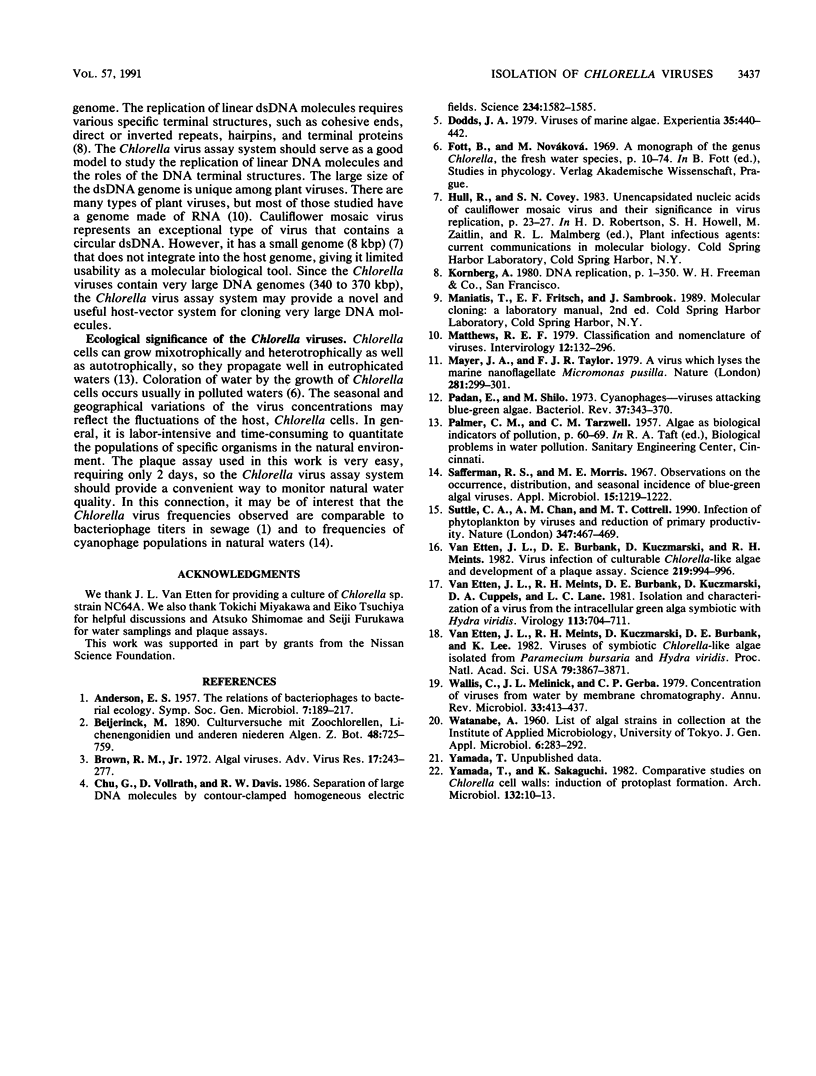Abstract
By using a plaque assay with the unicellular green alga Chlorella sp. strain NC64A as a host, viruses were screened from natural pond waters collected in Kyoto and Higashi-Hiroshima, Japan. From some samples tested, two kinds of plaques, large (φ = 6 to 10 mm) and small (φ = 2 to 3 mm), were detected with various frequencies. The frequency of plaques in each of the water sources was seasonal; generally, it reached a peak value (8,000 PFU/ml) in May and gradually decreased to the limit of detection (<1) in November before increasing again in early spring. Electron microscopy revealed that the purified and negatively stained viruses were very large (125 to 200 nm) icosahedral particles. The genome isolated from these particles was always a linear double-stranded DNA of 340 to 370 kbp. Electrophoresis patterns of the DNA fragments produced by digestion with restriction enzymes differed considerably from plaque to plaque, even for plaques from the same water source. However, Southern hybridization showed strong homology among all of the virus DNAs tested, indicating relatedness of those viruses. A possible use of the Chlorella virus assay system to monitor the natural population of algal cells and water quality is discussed.
Full text
PDF




Images in this article
Selected References
These references are in PubMed. This may not be the complete list of references from this article.
- Brown R. M., Jr Algal viruses. Adv Virus Res. 1972;17:243–277. doi: 10.1016/s0065-3527(08)60752-6. [DOI] [PubMed] [Google Scholar]
- Chu G., Vollrath D., Davis R. W. Separation of large DNA molecules by contour-clamped homogeneous electric fields. Science. 1986 Dec 19;234(4783):1582–1585. doi: 10.1126/science.3538420. [DOI] [PubMed] [Google Scholar]
- Matthews R. E. Third report of the International Committee on Taxonomy of Viruses. Classification and nomenclature of viruses. Intervirology. 1979;12(3-5):129–296. doi: 10.1159/000149081. [DOI] [PubMed] [Google Scholar]
- Padan E., Shilo M. Cyanophages-viruses attacking blue-green algae. Bacteriol Rev. 1973 Sep;37(3):343–370. doi: 10.1128/br.37.3.343-370.1973. [DOI] [PMC free article] [PubMed] [Google Scholar]
- Safferman R. S., Morris M. E. Observations on the Occurrence, Distribution, and Seasonal Incidence of Blue-green Algal Viruses. Appl Microbiol. 1967 Sep;15(5):1219–1222. doi: 10.1128/am.15.5.1219-1222.1967. [DOI] [PMC free article] [PubMed] [Google Scholar]
- VAN Etten J. L., Burbank D. E., Kuczmarski D., Meints R. H. Virus infection of culturable chlorella-like algae and dlevelopment of a plaque assay. Science. 1983 Feb 25;219(4587):994–996. doi: 10.1126/science.219.4587.994. [DOI] [PubMed] [Google Scholar]
- Van Etten J. L., Meints R. H., Kuczmarski D., Burbank D. E., Lee K. Viruses of symbiotic Chlorella-like algae isolated from Paramecium bursaria and Hydra viridis. Proc Natl Acad Sci U S A. 1982 Jun;79(12):3867–3871. doi: 10.1073/pnas.79.12.3867. [DOI] [PMC free article] [PubMed] [Google Scholar]
- Wallis C., Melnick J. L., Gerba C. P. Concentration of viruses from water by membrane chromatography. Annu Rev Microbiol. 1979;33:413–437. doi: 10.1146/annurev.mi.33.100179.002213. [DOI] [PubMed] [Google Scholar]






